
The 1950s were the beginning of a massive expansion of federal funding for basic, curiosity-driven science in the universities. An initiative of the Roosevelt administration, the unprecedented intrusion was floated on high-sounding rhetoric that ultimately prevailed over the concerns of a skeptical Congress. Scientists, so the story went, were intrepid adventurers exploring science’s “endless frontier.” The scientists had helped win the war, and the federal government should—was obligated to, it was asserted—help them, with gushers of money, floated on the romantic image of the scientist as intellectual adventurer.
This image of science is not unfair: post-war academic science was a wonder to behold. And there was a lot of money to fuel the fire. Since the end of World War II, federal funding of university research has doubled roughly every seven years, to its present $85 billion. The romantic image has been tarnished in recent years, but federal funding has not: the money continues to roll in, and to grow. The questions, therefore, arise: Are we getting what we are paying for? Is our knowledge of the natural world doubling every seven years, commensurate with the funding? Or is the money being dissipated in exponentially increasing frivolity and meaninglessness?
A recent paper in Nature casts these questions into stark relief. The authors analyzed the citation patterns of more than 45 million published papers, and roughly four million patents, from the 1950s to the present. They crafted a number they called the “coefficient of disruption,” or CD, which quantified whether a paper was “disruptive,” meaning that it changed a field dramatically, or “consolidating,” meaning that the paper was business-as-usual research. Here, from their article, is the money shot:
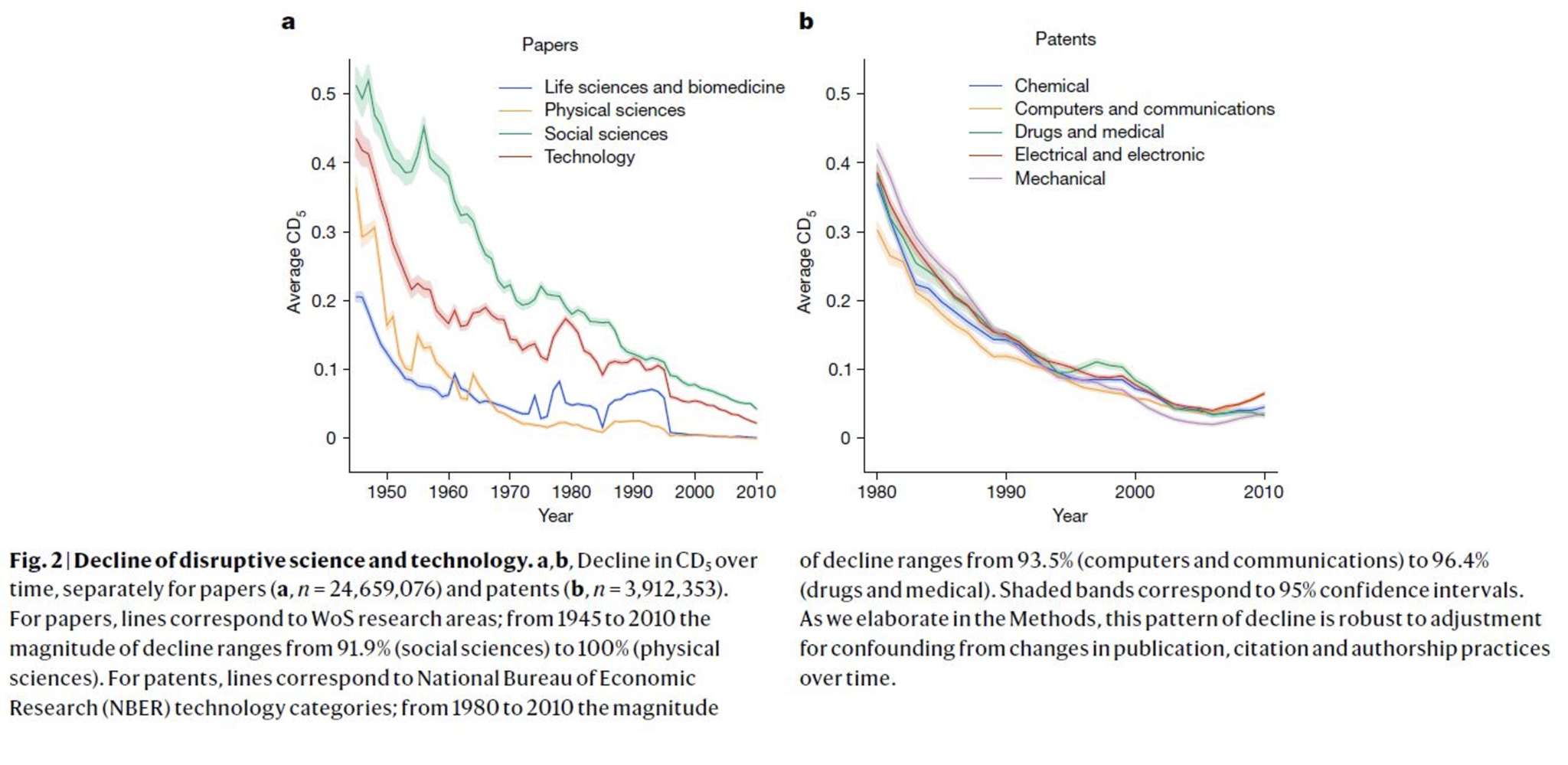
Figure 1. Coefficients of Disruption (CD) over time for research papers (left) and patents (right). (From Figure 2 of Park et al. 2023.)
So, that’s troubling. The massive federal intrusion into university science that began in the 1950s promised disruption: all that would come from exploring that endless frontier. We seem, rather, to be getting the opposite. The question asks itself: What are we getting for all this money spent on science?
To answer that question, we need to look at the method the Nature authors used to classify an article or patent as disruptive or consolidating. They used an analysis of patterns of citations between papers and patents. Every paper or patent contains a list of citations and references, which have, presumably, contributed something to the thought that went into it. That itself is a questionable assertion: citation analysis reveals something more like neighborhood gossip: who’s talking about whom, that sort of thing. That serves well enough in this case, however.
The Nature authors looked at citation patterns over time. Each of those 45 million articles constitutes a Target paper, which cites papers from the past (Predecessor papers). The Target paper and Predecessor papers in turn can be cited by Future papers. The coefficient of disruption is calculated from these patterns of citation.
A Target paper is ranked “consolidating” if Future papers cite both the Target paper and the Predecessor papers cited by the Target paper.
“Consolidating” Target paper
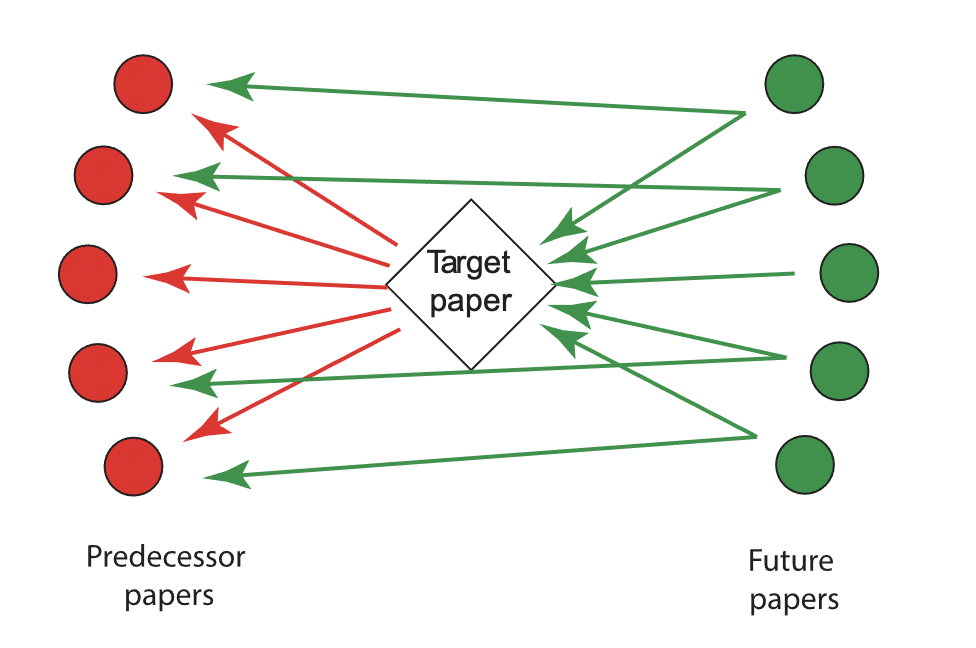
Figure 2. Citation patterns for “consolidating” papers. (Modified from Park et al.)
On the other hand, a Target paper is considered “disruptive” if Future papers no longer cite the Predecessor papers cited by the Target paper, but disproportionally cite the Target paper.
“Disruptive” Target paper
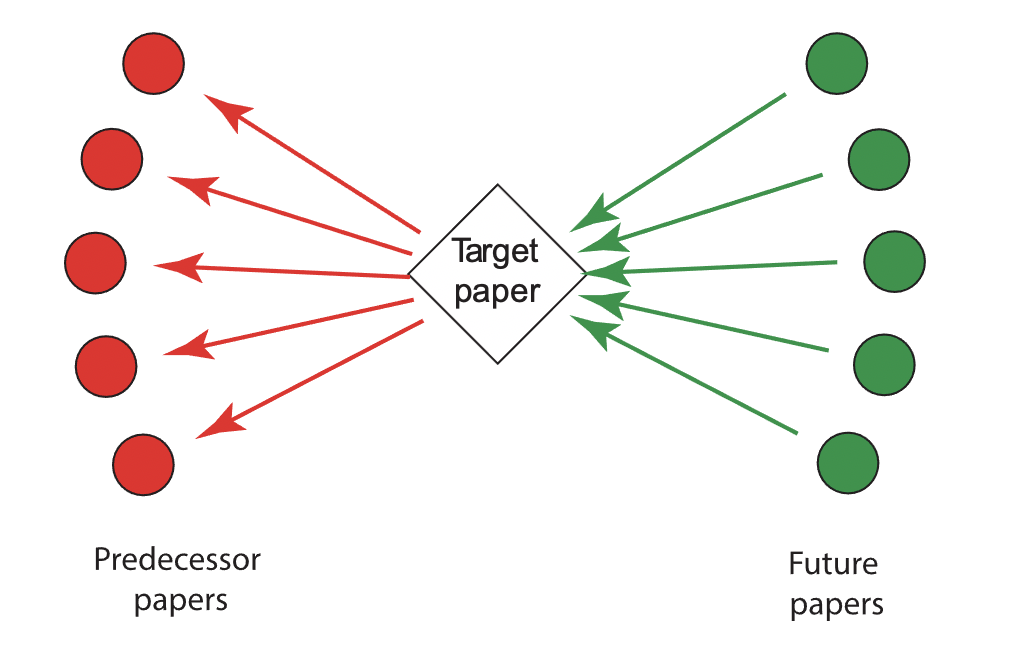
Figure 3. Citation patterns for “disruptive” papers. (Modified from Park et al.)
In short, disruptive papers are those that change the scientific conversation. We’re getting less and less of that over time, according to the Nature authors. Science now seems to be at that point in a dinner party conversation where everyone has run out of new things to say, but they keep talking anyway.
Could it really be that all that generous government funding is killing disruptive science? The study’s authors, to their credit, tested several ways the data could be explained short of that conclusion. Perhaps all the easy discoveries have been made, and discovery is becoming harder? Perhaps patterns of language have changed over time? They came up empty in every scenario they considered, and were left with the same conclusion as Nature: “no one knows why.” The one interesting result was that numbers (rather than proportions) of disruptive papers have been comparatively steady over time. Putting more explorers at the endless frontier has failed to increase the yield of that precious metal of discovery.
[Related: “Challenging the Academic Publisher Oligopoly”]
Our friends on the Right have jumped on this remarkable result to bolster various pet theories about the ongoing degradation of academia and the sciences. Steven Hayward, for example, attributes the decline to “the deadly confluence of ideology and the increasingly narrow conformism of academic specialties.” True enough, but inadequate, I think, to explain this. The ideological takeover of the sciences is a comparatively recent phenomenon. The decline in disruptiveness began in the 1950s, however, and has been declining steadily ever since. So, there’s something else at work, something more fundamental.
Here’s my pet theory: the generous funding of the academic sciences is itself the problem. Compare the rise of funding for academic science with the decline in disruptiveness (Figure 1):
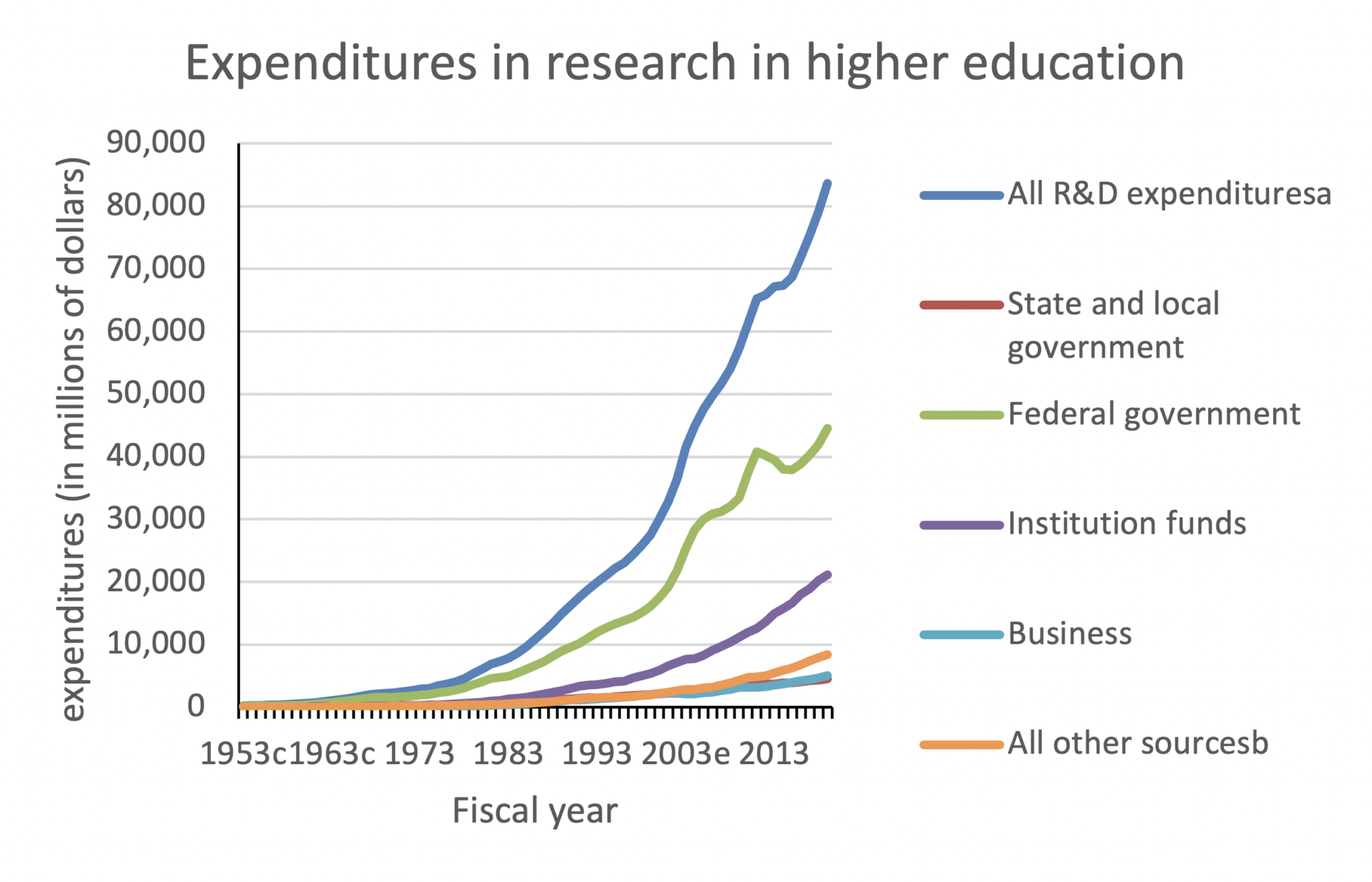
Figure 4. Patterns of funding of academic research. Source: Higher Education Research and Development Survey, National Science Foundation.
They are virtually mirror images of each other. More funding seems to correlate strongly with smothering disruptive science.
We can see the relationship between spending and disruptive science by plotting the coefficient of disruption against spending (Figure 5). The correlation stands, but now with an interesting twist. Disruptiveness was very high when spending was low, declined rapidly until 1980 or so, and then settled into a steady decline to the present.
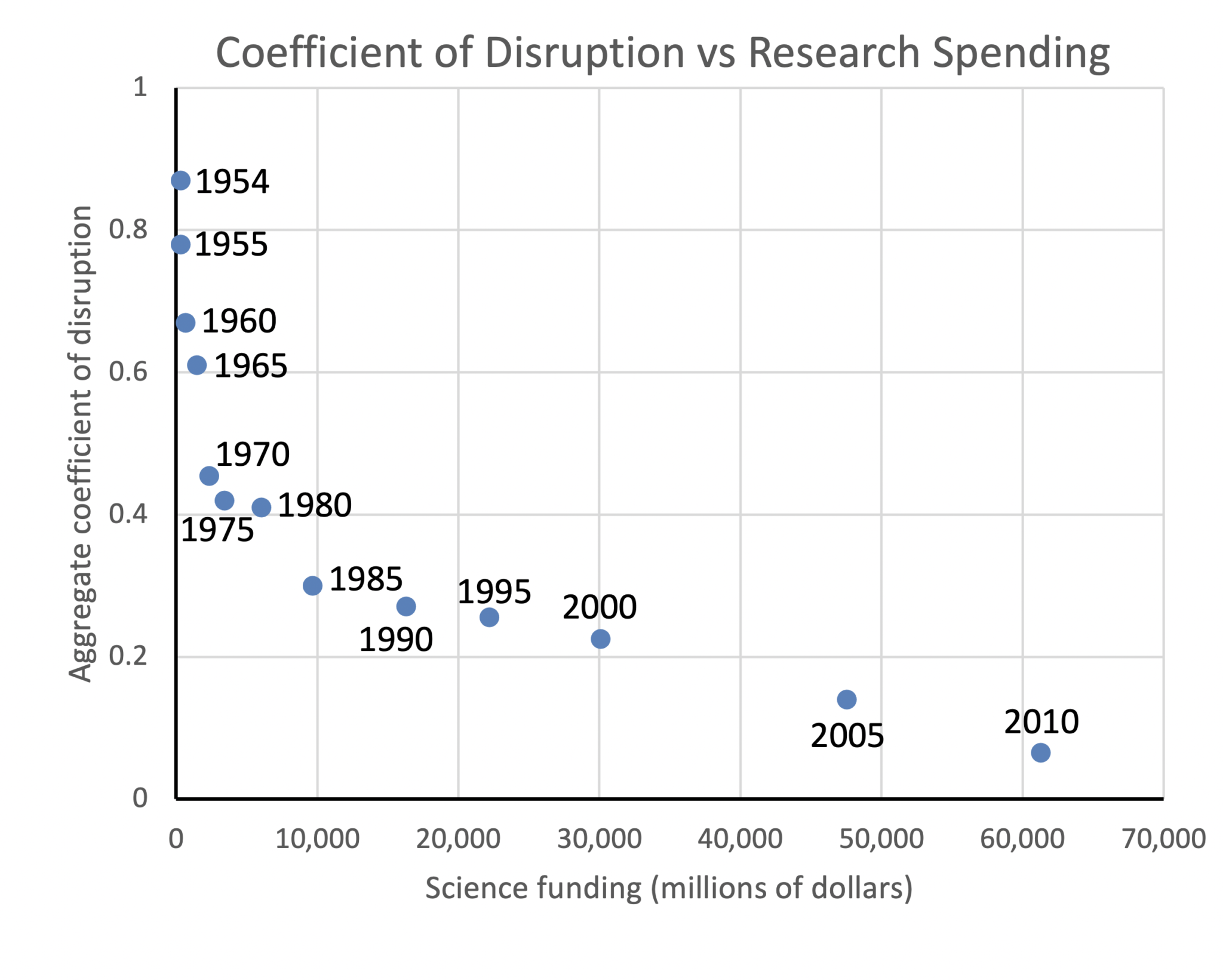
Figure 5. The inverse relationship between disruptive science and science spending. Aggregate coefficient of disruption is the sum of CDs for Life Sciences and Biomedicine, Physical Sciences, Social Sciences and Technology (Figure 1). Spending figures are from the Higher Education Research and Development Survey, National Science Foundation.
There seems to be a demographic dimension to this. But what is it?
Stephen Turner and Daryl Chubin have reflected on this problem in an interesting way. They argue that the massive increase in science expenditures since the 1950s has brought about a radical change in what they call the ethic of science. Whereas scientists prior to World War II built their careers around an “ethic of discovery,” the voluminous post-war revenue stream has transformed science into an “ethic of production.” In an ethic of discovery, scientists strive to be disruptive. Success lies in pushing back the “endless frontier.” Judgment of peers is crucial in determining whether, and how, the frontier had been pushed back. Rewards follow from doing disruptive work. In an ethic of production, however, scientists are judged by how scientifically “productive” they are, as measured by papers published and cited, students trained, and (most importantly) grants won.
[Related: “The Racialization of a Top Science Journal”]
Turner and Chubin argue that the numerous pathologies that afflict modern science follow from this shift in ethical norms, a shift, they point out, that has been driven by increased spending on science. These pathologies include: conformity; crowd-following; suppression of dissent; and denigration of the original or creative thinker. That is a recipe for producing “consolidating,” that is to say, unimaginative, research. Disruptive research is not welcome under an ethic of production.
The demographic dimension underscores the idea that it is increased science spending per se that is driving the decline. Since World War II, the actuarial tables have worked their inexorable way through the population of scientists. When science funding began to grow, the sciences were still populated by scientists who had grown up in an ethic of discovery. This is why those early years of federal science funding stand out for the high level of disruptive science (Figure 5). By the 1980s, roughly a generation later, the population began to shift to scientists who came up in an ethic of production. Presently, roughly another generation hence, the ethic of production has colonized nearly the entire population: there is little left of the ethic of discovery. As it is the exponentially increasing level of spending that has driven the shift, it’s hard to escape the conclusion that it is, in fact, the increasing spending that is driving the decline of disruptive science.
The inescapable conclusion is that we are spending tens of billions of dollars on essentially pointless scientific activity: exponential increases in papers that are never read, more and more scientists who seek affirmation rather than adventure, and institutions that value money and power more than fostering scientific discovery. In other words, our $85 billion (and growing) expenditure is fostering a generation of intellectual squishes and rent-seekers. This leads, in turn, to the really uncomfortable conclusion that the Nature authors seemed unwilling to explore, and that conservative commentators seem unable to draw: we are spending too much money on science.
The solution? Science will recover when an ethic of discovery can be restored. That will mean, among other things, shuttering the National Science Foundation, closing down all the extramural research programs presently managed by numerous federal agencies, and getting the federal government out of academic research altogether.
These are sacred cows that all the institutions of modern science will defend tooth and nail. Yet, by the terms of the 1950s idealistic vision that justified the federal intrusion into the academic sciences, the experiment has been a colossal failure. The course of action is clear: Shut down the experiment, choke off the ethic of production, thin the herd at the endless frontier, and disruption just might come back to the sciences—and the value of science to society along with it.
Image: Adobe Stock
Probabilism outcasts the Scientific Method so funding of ‘real’ science faces bankruptcy . Besides the number of schooled engineers are to be relocated to ecological control for sustainability. Empiricists found the positivist’s analytic process in placing value on truth statements too ‘strict’. Yet empiricists who grounded their research on the scientific method would find themselves surrounded by computer models and statisticians embarking on telling a story of global warming. Reported by Gerald Holton, the competition between scientists grounded on the scientific method and anti-scientists who sought a world view by predictive statistical methods, was recognized very early by Oswald Spengler (1880-1936). So, turning away from the search for exactitude and absolutes and adopting probabilism have undermined science from the inside. The scientific method has served for hundreds of years, solidifying the many theorems in mathematics, physics, chemistry and the laws of nature bequeathed from generation to generation. It is slowly being replaced by conjectured Bayesian estimations and predictions. Leticia Mayer, a specialist on the history of science, particularly probability and statistics affirms; A central feature of probabilism is that certainties are impossible. Probabilism is a term coined by O.H.K. Spate as a compromise between warring schools of environmental determinism and possibilism. . . a debate which geographers had argued over for most of the 20th Century, but it came at a time when the controversy was dying down, as geography switched from debating how the environment affected people to studying how people affected the environment.
Diana Anderson – “Who Made American Schools Marxist Training Centers”
Thank you for examining the ill pursuit of conformity in publishing – dismantling the scientific method.
We need to defund the NSF. They, like all government bureaucracies, are driven by politics. Consequently, the taxpayers are not getting their money’s worth. Not even close.
Outside of the academics who got the grant money, does anyone seriously believe studying a shrimp running on a treadmill is worthwhile? Why does NSF have a Division of Equity Excellence in STEM committed to enhancing opportunities for women, minorities and people with disabilities? (Silly me. I thought research should be funded based on its merits, regardless of who does it.) I wonder what the odds are of getting funding out of NSF to study any aspect of climate change that doesn’t adamantly believe man is the root cause of it.
If the research is worthwhile, academics should be able to get funding from industry or private foundations. America is broke. We don’t have the money to fund woke NSF projects.
I’ve read other research claiming that review articles tend to replace primary research articles in citation chains. Far from being disruptive, review articles might be considered consolidating.
I don’t agree with the most foundational premise in your position — the installation of capital ‘S’ “Science” as something in and of itself — something iconic, sacred, almost worshipful that we might stare (up) at and assess as well or mis- served. I disagree, too, with the follow-up inference that there are those who are the true and high scientists — those who best personify the ethos and deserve most to be enabled and unshackled;
That said, I certainly agree that disruptive, discovery oriented scientists ought to be well supported and little encumbered, and be extolled in some relation to their genuine place on the Einstein scale.
But I look at the massive funding and varying worth of work by countless scientists in myriad institutions (public, private, higher ed and not) as a fantastic ASSET. That many of these people are bound to corporate or governmental missions is a good thing, even if it means many efforts are non-disruptive, and some even are worthless dead ends. This is the manifestation of a science-valuing citizenry doing what it can. The conservative in me wants us to fight off as many tragedy-of-the-commons consequences as we can, but, I think, better to maintain a fully funded assortment of possibly mis-employed but always re-directable scientists than to “thin the herd.”
You wrote, “Science will recover when an ethic of discovery can be restored.” I think, rather, that, to the extent that the “ethic of discovery” is missing, that ethic of discovery ought to be restored. “Science” per se, I think, is best not dressed up and paraded about as a deity, but rather remembered first for its humblest of roots as a method — a method that well infuses the pursuits of millions.
Stating the obvious (and evocative graphics notwithstanding), ‘on-the-rise’ and ‘in-decline’ can apply to the same phenomenon, depending on frame of reference — but only if those frames are simplistic and polar. I’m all for adding/sustaining/restoring/ ‘high Science’ and its rightful leaders, and for liposctioning away administrative and regulatory bloat and authority. But I’m also happy to see my tax dollars (and share of commercial product and service spending) go to much of the ‘low science’ work that serves the fine grain of established society — a polymer here, a species find there, etc.
Cheers!
Several thoughts: First and foremost, correlation does not prove causation. Secondly,
I have observed many problems associated with funding over the past few decades. Among others, within academia, in many places scientists are rewarded [promotion, tenure etc.] by how much money they bring to the University, not on the basis of the quality of their work. Money brought in is so easily quantified! Then, the need to compete for funding tends to channel energies into safer areas rather than potentially “disruptive” ones, which by their very nature are likely to meet challenges & objections, and rejection of funding.
It’s true that Karolin Kariko had a hard time. Not surprising perhaps, having been an immigrant (yes, one of those) who got her Ph.D. at a pretty obscure East European university, and ended up doing unconventional work here in the U.S. (Yeah, that disruptive stuff that supposedly is disappearing). But she persisted and eventually got in with Drew Weissman (both at U. Penn). There was a lot of money from NIAID (yes, the place where that guy Fauci worked). A groundbreaking paper came out in 2005. So the system worked — very well, after a fashion — and I very much doubt that there would have been any Operation Warp Speed without the grinding away at this taxpayer funded, academic research. I’ve heard Weissman talk about this work and it’s striking how dogged and determined he seems even now.
Here’s a place to read about all this:
https://www.ncbi.nlm.nih.gov/pmc/articles/PMC8426978/
I read the original paper and have followed the controversy.
I agree that ‘productivity’ – as measured by administrators – is a big part of the problem. It’s rather like fund managers who prefer to invest in stocks that give steady returns.
The Figure 5 could benefit from a log-log plot… it would be almost linear
In reply to Jonathan: the woman who pushed mRNA vaccines forward was repeatedly denied NIH funding and was lucky to find a post at a company.
I’m inclined to think that a reduction in the ethic of discovery is more of a consequence than a cause of the reduction in disruptive science. If most of the low-lying fruit has already been picked, the legions of scientists working today have little alternative than to do their best with less imaginative projects. Most researchers would be delighted to do something highly original, but it is becoming more difficult.
The statistics that show a fairly stable rate of production of disruptive papers over time but a significant decline in the percentage of disruptive papers is perhaps explainable by the simple conjecture that the increasing difficulty in achieving a breakthrough is more or less balanced by the increasing number of scientist working to advance their fields. Some support for this explanation may be seen in the statistic that scientists are increasingly citing older work and work more narrowly tailored to their interests. The knowledge explosion is outstripping scientists’ ability to absorb and benefit from it.
Not mentioned is research overhead, which 30 years ago became a national scandal, only to be quietly ignored. It is at least a corrupting influence and one that ought not be ignored.
An other thing to remember is that we were at war for 50 years — 1941-1991 — and that a lot of the Federally-funded research initially had a clear National Defense focus — to show the world that we were better than the Communists. (This is why research into the humanities was funded — and don’t think that the space race wasn’t political.)
It’s also important to remember that the atomic bomb was not the only way the scientists contributed to the war effort. Radar and sonar come to immediate mind, and those technologies won the Battle of the Atlantic.
The funding chart is missing the sixth line and it would be interesting to see how much State & Local Governments have increased funding — and what they are funding.
More horrible ideas promulgated by the National Association of Scholars. The author appears to be a would-be disrupter who however late in his career is at a second or third tier university. In fact, his interests and ideas strike me as rather mundane. I wonder if he is a frustrated grant seeker!
Of course there is less “disrupive” science now than in the past. There are more scientists by a large multiple. A century ago and some, there was one Einstein — maybe kind of a freakish fluctuation anyway — and a Planck and a Bohr and a Heisenberg and a Schrodinger. It is unrealistic to expect that there would be a hundred of each today. Plus, there’s a lot of reason to suspect that the low-hanging fruit has already been picked. Some pretty smart, adventurous people have tried really hard to make progress, say, in quantum gravity. But quantum mechanics and relativity have already been discovered. It doesn’t seem so easy to make a comparable leap today. I invite J. Scott Turner to try it. For that matter, the genetic code has already been discovered. As the great Richard Feynman put it, the fundamental laws can only be discovered once. I suspect he said this kind of ruefully.
OK, maybe science grinds on glacier-like nowadays. It is still producing pretty impressive results. mRNA vaccines and Operation Warp Speed were enabled by that “non-disruptive” academic research of a couple of decades ago. If quantum computing ever really gets going, we damn well better hope that our academic researchers beat the rest of the world to it.
Closing down federal research support is about the dumbest idea I’ve heard since Donald Trump recommended bleach or something to stop covid!
Our universities, the media, and the Democrat Party lead the charge to political correctness and groupthink. We must have uniformity of thought, language, and behavior. Uniformity, uniformity, uniformity goes the cry. I spent more than 40 years in manufacturing, all of it involving technology and quality assurance. A saying in my field attributed to Edward Deming1 is considered to be profound :
Uncontrolled Variation is the Enemy of Quality
We’re all in favor of quality aren’t we? Deming is surely right so let’s control or eliminate variation.
There is another side to that coin of my own formulation:
Uniformity is the Enemy of Knowledge©
Scientists learn by conducting experiments in which they change input conditions and study output results. If a plant manager hires engineers only from one college or university he greatly weakens design and problem solving capability. If our schools succeed with their current drive to uniformity, they will simultaneously defeat their primary purpose, the discovery, propagation, and preservation of knowledge. We taxpayers should not allow government to continue pouring money into the current education system. Uniformity in hiring is not helpful, nor is tenure. Peer review is of no value once reviewers are weeded to be of like mind. If “publish or perish” is the maxim, no one will care if published work can’t be reproduced. Professional societies are of little value if they serve only to enforce conformity, say by having outgoing officers serve as a nominating committee for next year’s officers, or by nominating a single individual for each office, i.e. offering no real choice. Critical theory is no help. It ignores facts, choosing to follow Rousseau’s and others emotions. Which lawyer will be our Robespierre?